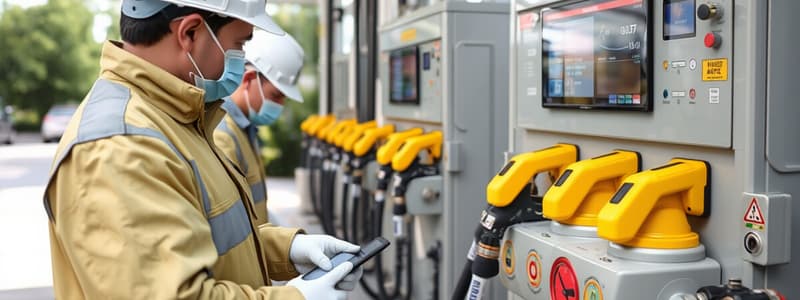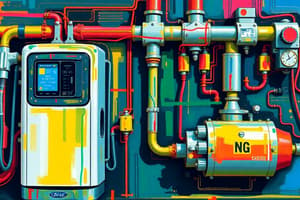Podcast
Questions and Answers
How often does a CNG cylinder inspection need to be done?
How often does a CNG cylinder inspection need to be done?
CNG cylinder inspections are required every three years, or 36,000 miles, or after any fire or accident.
What is the major constituent in natural gas?
What is the major constituent in natural gas?
Methane
Which fuel has the lowest carbon content?
Which fuel has the lowest carbon content?
Natural gas
What is the chemical composition of methane?
What is the chemical composition of methane?
Natural gas is ____.
Natural gas is ____.
Natural gas has which of the following characteristics?
Natural gas has which of the following characteristics?
What is the ignition temperature of natural gas?
What is the ignition temperature of natural gas?
For natural gas, the lower the flammability limit is ____% and the upper flammability limit is ___%.
For natural gas, the lower the flammability limit is ____% and the upper flammability limit is ___%.
What are the human health hazards that must be considered when working on CNG vehicle?
What are the human health hazards that must be considered when working on CNG vehicle?
What is the maximum fill pressure of a 3,600 PSI cylinder?
What is the maximum fill pressure of a 3,600 PSI cylinder?
What is the minimum burst pressure of a high pressure fuel line?
What is the minimum burst pressure of a high pressure fuel line?
What is the minimum burst pressure of a 3600 PSI CNG cylinder?
What is the minimum burst pressure of a 3600 PSI CNG cylinder?
These are true statements about compressed natural gas.
These are true statements about compressed natural gas.
The rated service pressure of CNG cylinders is measured at what temperature?
The rated service pressure of CNG cylinders is measured at what temperature?
What standards address CNG cylinder design in manufacturing?
What standards address CNG cylinder design in manufacturing?
The primary installation code for CNG cylinders and fuel system components is ____.
The primary installation code for CNG cylinders and fuel system components is ____.
Why is NFPA 52 important?
Why is NFPA 52 important?
When inspecting CNG cylinders, the primary inspection guidance document is ____.
When inspecting CNG cylinders, the primary inspection guidance document is ____.
What is NGV2 #1?
What is NGV2 #1?
What is NVG2 #2?
What is NVG2 #2?
What is NVG2 #3?
What is NVG2 #3?
What is NVG2 #4?
What is NVG2 #4?
What are the primary causes of CNG cylinder failure?
What are the primary causes of CNG cylinder failure?
What does the CNG fuel receptacle do?
What does the CNG fuel receptacle do?
Which CNG fuel system component prevents gas from flowing to the engine when the key is on, but the engine is not running?
Which CNG fuel system component prevents gas from flowing to the engine when the key is on, but the engine is not running?
Type 3 CNG cylinders are made of ____.
Type 3 CNG cylinders are made of ____.
Type 4 CNG cylinders are made of ____.
Type 4 CNG cylinders are made of ____.
The most significant safety hazard with CNG cylinders is ____.
The most significant safety hazard with CNG cylinders is ____.
The CNG fuel receptacle contains a check valve designed to ____.
The CNG fuel receptacle contains a check valve designed to ____.
The O ring inside the fuel receptacle provides ____.
The O ring inside the fuel receptacle provides ____.
The secondary check valve is ____.
The secondary check valve is ____.
The defueling system is ____.
The defueling system is ____.
What is ANSI NGV1?
What is ANSI NGV1?
What is ANSI NGV2?
What is ANSI NGV2?
What is DOT FMVSS 304?
What is DOT FMVSS 304?
What is ANSI PRD?
What is ANSI PRD?
What is ANSINGV 3.1?
What is ANSINGV 3.1?
What are the three types of codes and standards?
What are the three types of codes and standards?
What is the National Fire Protection Association NFPA 52 vehicular natural gas fuel system code?
What is the National Fire Protection Association NFPA 52 vehicular natural gas fuel system code?
What is ANSI NGV 6.1?
What is ANSI NGV 6.1?
What are the codes and standards documents for inspectors?
What are the codes and standards documents for inspectors?
What is the primary document to be used for cylinder manufacturers inspection guidelines?
What is the primary document to be used for cylinder manufacturers inspection guidelines?
What is a fuel receptacle?
What is a fuel receptacle?
What is a secondary check valve?
What is a secondary check valve?
What is a defueling system?
What is a defueling system?
What do fittings like O Ring Face Seal and Double Ferrule do?
What do fittings like O Ring Face Seal and Double Ferrule do?
What are cylinder valves?
What are cylinder valves?
What are PRDs and vent lines?
What are PRDs and vent lines?
What are fuel system isolation valves?
What are fuel system isolation valves?
What is fuel system isolation valves operation?
What is fuel system isolation valves operation?
What does a high pressure coalescing filter do?
What does a high pressure coalescing filter do?
What is a fuel shutoff solenoid valve?
What is a fuel shutoff solenoid valve?
What does a high pressure gauge do?
What does a high pressure gauge do?
What is a high pressure transducer?
What is a high pressure transducer?
What does a pressure regulator do?
What does a pressure regulator do?
Type 1 CNG cylinders are made of what?
Type 1 CNG cylinders are made of what?
Type 2 CNG cylinders are made of what?
Type 2 CNG cylinders are made of what?
Type 3 CNG cylinders are made of what?
Type 3 CNG cylinders are made of what?
Type 4 CNG cylinders are made of what?
Type 4 CNG cylinders are made of what?
What are the primary causes of CNG cylinder failure?
What are the primary causes of CNG cylinder failure?
What does the CNG fuel receptacle do?
What does the CNG fuel receptacle do?
What is a fuel shutoff solenoid valve?
What is a fuel shutoff solenoid valve?
What do Type 1 CNG cylinders entail?
What do Type 1 CNG cylinders entail?
What do Type 2 CNG cylinders entail?
What do Type 2 CNG cylinders entail?
What do Type 3 CNG cylinders entail?
What do Type 3 CNG cylinders entail?
What do Type 4 CNG cylinders entail?
What do Type 4 CNG cylinders entail?
Flashcards are hidden until you start studying
Study Notes
CNG Cylinders and Inspections
- CNG cylinder inspections are mandatory every three years, every 36,000 miles, or after incidents like fires or accidents.
- NFPA 52 is the primary installation code for CNG cylinders and fuel system components, aiding in identifying unsafe practices.
Natural Gas Composition and Characteristics
- Major element of natural gas is methane, with a chemical formula of CH4.
- Natural gas is lighter than air and is odorless.
- It has the lowest carbon content compared to other fuels, making it more environmentally friendly.
Ignition and Flammability
- Ignition temperature of natural gas ranges from 900°F to 1080°F.
- Flammability limits: lower limit is 5%, upper limit is 15%.
Health Hazards of CNG
- Significant hazards include high pressure, fire risks, and asphyxiation when handling CNG vehicles.
Cylinder Pressure Details
- Maximum fill pressure for a 3,600 PSI CNG cylinder is 4,500 PSI.
- CNG cylinders must withstand a minimum burst pressure of 8,100 PSI.
Cylinder Design Standards
- CNG cylinder design must comply with ANSI NGV 2 and FM VSS304 standards.
- Various types of cylinders (Type 1, Type 2, Type 3, Type 4) differ in materials and load capacities.
CNG Cylinder Failures
- Primary cause of failures is undetected external damage, often leading to ruptures during fueling.
Fuel System Components
- The CNG fuel receptacle includes a check valve to prevent backflow and requires an O-ring seal.
- A fuel shutoff solenoid valve stops gas flow to the engine when the vehicle is on but not running.
CNG Defueling Systems
- Requires trained personnel for operation and must be leak-checked during inspections.
Pressure Regulation
- High-pressure coalescing filters remove contaminants from gas.
- Pressure regulators reduce high pressure to suitable engine operating pressure.
Codes and Standards
- Important standards include ANSI NGV 1 (fueling connections) and ANSI NGV 6.1 (storage and delivery systems).
- Codes and standards documents are crucial for inspectors, including CGA C 6.4 and manufacturer guidelines.
Safety Measures
- Secondary check valves are installed to prevent gas from reverting back into the receptacle.
- Fuel system isolation valves allow for emergency gas shutoff to the engine.
Cylinder Types
- Type 1: All metal (steel/aluminum) with all load on the liner.
- Type 2: Steel/aluminum with hoop overwrap, with part of the load on the composite.
- Type 3: Thin liner with complete overwrap, with a majority of the load on the composite.
- Type 4: Plastic liner with full composite overwrap, with no load taken by the liner.
Maintenance and Inspection Guidelines
- Follow cylinder manufacturers' guidelines for inspections, with CGA C 6.4 as the secondary document.
- NFPA 52 details requirements for defueling systems and fuel system inspections to ensure safety.
Studying That Suits You
Use AI to generate personalized quizzes and flashcards to suit your learning preferences.




